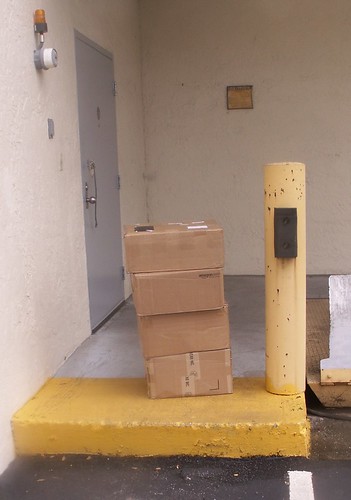My Reading Assignment

I recently signed up to be part of the Science Fiction and Fantasy Writers of America's Circulating Book Plan. Under this plan, SFWA members circulate new sf/f releases amongst ourselves. Volunteer readers in each region then forward the books to repositories -- usually public and university libraries -- located throughout the U.S.
In addition to familiarizing myself with scads of new books for the cost of Media Mail postage, this gives me a chance to give my own work added exposure. Once Covenant is released I'll send copies to the different regions for circulation.
The boxes shown here were waiting for me at the post office this week. I won't lack for reading material for a while....
Earlier in the week I crossed the 20,000-word mark on Book #6. I also spent some time in Movie Mode, finally catching up a bit on films I'd been curious about because I go to a movie theater maybe once a year. Rented three, then bought one.
I generally don't buy movies for myself, so when I do it's a special occasion. Good Night, And Good Luck is my latest "must have," not only for the movie itself but also for the Commentary by Director/Screenwriter George Clooney and Producer/Screenwriter Grant Heslov.
I was grooving something fierce on the commentary's discussion (mostly by Clooney). The commentary goes blow-by-blow through the movie, addressing decision points on what kind of film to use, what lens length, what camera angle, what information to include or not. When to focus on the speaker and when to focus on the listener, because often it's the response to something that creates drama. Even before I saw the commentary feature I found myself watching the movie for craft. One particular scene near the end caught my eye for its sandwiching of (1) onstage discussion, (2) offstage discussion, and (3) onstage discussion recapitulating the information presented offstage. The transition between (2) and (3) is so subtle that at the last moment it almost seemed as though (2) would be onstage, but presenting the information in (3) made more dramatic sense.
When I have enough clones to do everything I want to do (I'll take a six-pack of clones and an extra side of Sundays, please), I plan to make a list of the cinematic decision points and find their counterparts in literature because I see a solid correspondence between the two. Paying attention to how movies are crafted has informed me on story-crafting because I use a kind of internal cinema. Clooney made the comment that Good Night, And Good Luck is a talking head picture, with its main drama residing in the words (as opposed to, say, blowing stuff up). Using the medium of film to do justice to those words added an extra layer of challenge to the work.
I think movies in general can be deconstructed and their decision points linked to those in writing (beyond screenwriting) as a way to illustrate those decision points, but the extra layer of sculpting a "word" picture into drama makes this movie a terrific bridge between the two media. I was viewing Clooney's commentary as a treatise on writing as much as it was a treatise on film. I think it's valuable as a teaching tool for both, separately and in combination. In my own course I present and deconstruct excerpts taken from written works in different genres, showing how particular words and combinations of words are used to create tone, rhythm, narrative speed, image, etc.
And speaking of movies...
Recently I watched an interview with Ernest Lehman (screenwriter for Alfred Hitchcock's North by Northwest) on TCM. I tuned into the interview as Lehman commented on the story's genesis.
From the Internet Movie Database: "Hitchcock ... had only three ideas to set Lehman on his way: mistaken identity, the United Nations building, and a chase scene across the faces of Mt. Rushmore."
That's how it all started. No characters. No plot. Lehman started with those disparate ideas and then developed his characters and the story line, including figuring out how to move his characters from Madison Avenue in New York to Mt. Rushmore in South Dakota.
I could identify with Lehman's comments because in addition to Book #6, I'm drafting a short story that came to me first as an image and a visual pun of sorts. Since an image does not a story make, I started developing the story from there. In recent discussions I've been pointing out that ideas for any kind of creative expression can come from anywhere and can come in any way, shape, or form. It doesn't have to start with plot, or with character, or at the beginning. It doesn't have to be linear. It doesn't have to remain static. One of the people in my free-writing group finds correspondences between writing-process details and her own process when she paints.
I love those kinds of creative bridges. I want to play with them and put them into some kind of intelligible form in my "copious spare time" (as a former boss once put it). That activity goes on my Long-Range To Do List.
On my Short-to-Middlin'-Range To Do List, I have some reading to do.
 | Deviations: Covenant can be pre-ordered from Aisling Press. The Deviations page has additional details. |











0 Comments:
Post a Comment
<< Home